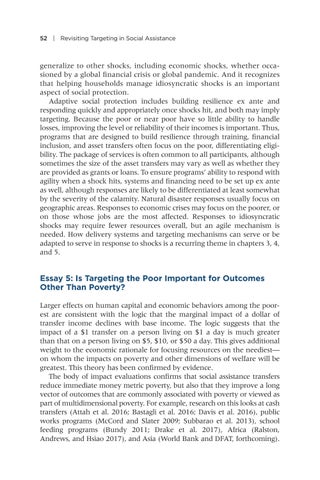52 | Revisiting Targeting in Social Assistance
generalize to other shocks, including economic shocks, whether occasioned by a global financial crisis or global pandemic. And it recognizes that helping households manage idiosyncratic shocks is an important aspect of social protection. Adaptive social protection includes building resilience ex ante and responding quickly and appropriately once shocks hit, and both may imply targeting. Because the poor or near poor have so little ability to handle losses, improving the level or reliability of their incomes is important. Thus, programs that are designed to build resilience through training, financial inclusion, and asset transfers often focus on the poor, differentiating eligibility. The package of services is often common to all participants, although sometimes the size of the asset transfers may vary as well as whether they are provided as grants or loans. To ensure programs’ ability to respond with agility when a shock hits, systems and financing need to be set up ex ante as well, although responses are likely to be differentiated at least somewhat by the severity of the calamity. Natural disaster responses usually focus on geographic areas. Responses to economic crises may focus on the poorer, or on those whose jobs are the most affected. Responses to idiosyncratic shocks may require fewer resources overall, but an agile mechanism is needed. How delivery systems and targeting mechanisms can serve or be adapted to serve in response to shocks is a recurring theme in chapters 3, 4, and 5.
Essay 5: Is Targeting the Poor Important for Outcomes Other Than Poverty? Larger effects on human capital and economic behaviors among the poorest are consistent with the logic that the marginal impact of a dollar of transfer income declines with base income. The logic suggests that the impact of a $1 transfer on a person living on $1 a day is much greater than that on a person living on $5, $10, or $50 a day. This gives additional weight to the economic rationale for focusing resources on the neediest— on whom the impacts on poverty and other dimensions of welfare will be greatest. This theory has been confirmed by evidence. The body of impact evaluations confirms that social assistance transfers reduce immediate money metric poverty, but also that they improve a long vector of outcomes that are commonly associated with poverty or viewed as part of multidimensional poverty. For example, research on this looks at cash transfers (Attah et al. 2016; Bastagli et al. 2016; Davis et al. 2016), public works programs (McCord and Slater 2009; Subbarao et al. 2013), school feeding programs (Bundy 2011; Drake et al. 2017), Africa (Ralston, Andrews, and Hsiao 2017), and Asia (World Bank and DFAT, forthcoming).


